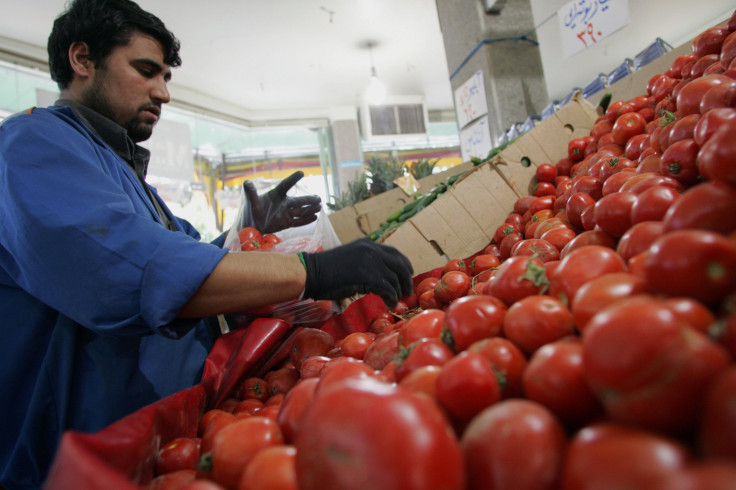How US Sanctions Impact Everyday Prices, Living Costs In Iran

The United States sanctions on Iran prompted higher export of tomatoes from the latter due to low profit in local markets, leading to a scarcity in the country, a report said Thursday.
Prices of everyday goods and other commodities have sharply risen as well, thus increasing the overall living costs of common people in Iran.
After the sanctions were imposed by the U.S., the value of the Iranian rial fell drastically till a few weeks ago when its value suddenly started climbing again.
The value of rial fell by more than 70 percent since May this year when President Donald Trump pulled out of a multilateral deal, known as the Joint Comprehensive Plan of Action (JCPOA), due to its “disastrous flaws” that, according to him, posed a security threat. Trump said the existing deal was not strict enough. Soon after, two sets of sanctions on Iran were announced by the government.
The first set of sanctions came into effect on Aug. 7 and it put a restriction on Iran’s purchase of U.S. currency, trade in gold and other precious metals, and the sale to Iran of auto parts, commercial passenger aircraft, and related parts and services.
This led to a scramble for foreign currency within the Middle Eastern nation which automatically made exports more valuable than selling it locally for tomato producers. Tomato, an abundant crop in the country, is a staple of Iran cuisine. With the limited amount of tomatoes available due to exports, people in Iran started panic-buying, a report in Reuters said.
The purchase of tomato paste, used in many Persian dishes, was even limited by some shops. As people bought up all existing stocks, some lines were completely sold out of the product.
To curb the situation, the government banned tomato exports, a move aimed at limiting the economic instability in the country, but it has given rise to multiple public protests and harsh criticism of the government.
#Iran currency, rial, lost its gains after Majlis approved FATF legislation, now trading at 152,000 rials to the dollar. On Monday, merchants went on strike, closing bazaars, in protest against currency instability, skyrocketing prices, and loss of people's purchasing power pic.twitter.com/c0y0twUSfa
— Nader Uskowi (@nuskowi) October 9, 2018
According to the report, the ban did little to alleviate the situation as traders started to illegally export tomatoes to other countries.
“We have heard that trucks full of tomatoes are still leaving the country, especially to Iraq,” Mohammad Mir-Razavi, head of the Syndicate of Canning Industry, said.
“They put boxes of greenhouse tomatoes on top and hide normal tomatoes at the bottom,” he added referring to how tomatoes were smuggled through an exemption in the ban for hot-house grown tomatoes.
Tomatoes are just one of the examples of how the U.S. imposed sanctions are affecting the day to day lives of normal Iranian citizens, while at the same time benefitting a small part of the population that has access to hard currency.
A bottle of milk in Iran was priced at 15,000 rials ($0.36) last year. Currently, it sells at 36,000 rials ($0.86), which is more than double the original price. The price jump is most noticeable in imports such as mobile telephones and other consumer electronics, which sells at a much higher price due to the currency's current standing against the U.S. dollar.
The price of tomatoes has increased five-fold compared to last year, the Reuters report said.
Even though the government mounted a campaign against the price hike by ordering shopkeepers to sell products at lower prices, some responded by not selling anything or limiting the number of items sold.
The second set of sanctions, which will come into effect from Nov. 4, will restrict the sale of oil and petrochemical products from Iran, a report in Council on Foreign Relations said. This could lead to a strain in global oil supply while further worsening the situation of normal Iranians.
Some fear an economic slump worse than the period from 2012 to 2015 when it last faced similar sanctions.
“There is an emerging consensus that the economy will go through a period of austerity similar to that recorded during the Iran-Iraq war,” Mehrdad Emadi, an Iranian economist who heads energy risk analysis at London’s Betamatrix consultancy, said.
Since the sanctions were first put into place, the cost of living in Iran has soared as the rial fell against the dollar. It reached an all-time low of 190,000 to the U.S. dollar on the unofficial market in later September, according to a report on RFERL. It was trading at 170,000 to the dollar by Oct. 1 and was at 135,000 to the dollar on Oct. 2.
But economists warned that Iran's economic conditions are most likely worsen further.
"The government has attempted to address the rial with tactics -- raising interest rates on savings, giving residency permits for people bringing foreign currency into country, and by restructuring the foreign exchange market," Scott Lucas, an Iran specialist at Birmingham University in Britain and editor of the EA World View website, said. "But if you can't assure trade, investment, and production, you can't defend the rial."
Meanwhile, Iranians continue to struggle with the unstable currency and surging prices of commodities.
Peyman Mohammadian, 28, an unemployed university graduate in the western city of Andimeshk, converted 5 billion rials in savings into dollars in September in an attempt to protect his money.
“On one hand, I want the dollar to rise so I don’t lose my money. But on the other hand, I want it to drop below 100,000 — otherwise inflation will be so high that I won’t be able to get married for 10 years,” he said.
© Copyright IBTimes 2024. All rights reserved.





















